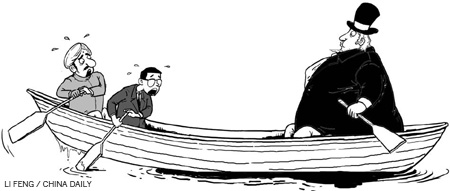
Nervous sell-offs in Asia's equity markets in response to debt problems in the United States and the eurozone underscore the region's growing links to financial events on the other side of the world. But with increased integration comes the increased threat of contagion. It is therefore not only in Asia's interest to promote global financial stability, but also its economic fate increasingly depends on it.
Asia was fortunate to escape the 2008-09 global financial crisis relatively unscathed. One critical reason was its limited exposure to subprime mortgages and other "toxic" assets in the US. The region's underdeveloped financial markets were relatively "clean" of complex derivative and securities deals.
There is no guarantee that the same will hold true next time around. In fact, the more financial deepening and globalization continue, the greater the likelihood that turmoil in one country will spread rapidly across other countries and regions, inflicting significant economic damage as it goes.
Already, global financial markets are so deeply intertwined that investors in Helsinki happily make money in Hong Kong, while a default in Madrid can make bankers lose hair in Mumbai.
In theory, freer capital mobility is welfare enhancing - it promotes better and more efficient allocation of financial resources worldwide. But history is witness to large and volatile short-term capital flows complicating macroeconomic management, destabilizing weak financial systems, and disrupting growth in emerging economies.
Financial markets in emerging Asia - the Chinese mainland, Hong Kong and Taiwan, and India, Indonesia, the Republic of Korea, Malaysia, the Philippines, Singapore, Thailand and Vietnam - have seen a flood of capital inflows over the past several years, accelerating the region's strong recovery and increasing investors' appetite for higher-yielding investments in the region.
The upsurge in capital flows has been a decidedly mixed bag. Emerging Asia attracts a sizeable share of total capital flows to emerging economies worldwide. While more than half of these flows are stable, long-term overseas direct investments, the bulk go to China. Excluding China, the region attracts a mere 10 percent of total overseas direct investment flows to emerging economies. In contrast, emerging Asia receives a far greater portion of total short-term capital flows - such as bank lending and portfolio investments - than any other developing region.
Historically, short-term capital flows are more volatile and far more prone to a "sudden stop" compared with long-term alternatives like overseas direct investment. For instance, as investors became unnerved by the unrest in the Middle East and North Africa, and fiscal trouble in Europe and the debt ceiling impasse in Washington, portfolio investment flowing to emerging Asia dropped sharply.
So how can emerging Asia's policymakers contribute to financial stability as the region's markets develop?
Financial integration and contagion are two sides of the same coin. It is unlikely that the trend of financial globalization will reverse. Thus, rapid financial liberalization must be accompanied by mechanisms to ensure the effective use of foreign capital. Some conditions are a prerequisite for rendering capital flows more stable and long-term (and hence less disruptive) to an economy. These include sound macroeconomic management, a high level of financial sector and market development, and effective institutions and good governance.
First, it's time the region strengthened its macroeconomic policy and regulatory frameworks to attract safer, longer-term investments. Despite visible improvements in recent years, major vulnerabilities persist and must be dealt with. The 1997-98 and 2008-09 crises revealed the region's vulnerability to large and procyclical short-term capital flows and excessive exchange rate volatility.
Second, domestic capital markets must be made deeper and more fluid, with broader investor bases, more diverse and innovative local financial products, improved regulatory frameworks and better market institutions and infrastructure. This can help unlock capital to meet the region's huge infrastructure financing needs. It is equally important to ensure that the financial sector and market development benefit the wider public with inclusive measures to broaden access to finance for families, small- and medium-sized enterprises, and other traditionally underserved market segments. This can help promote financial stability while reducing the worrying trend of rising inequality.
Third, equal access to information, strong corporate governance and accountability, political stability, the rule of law and control over corruption are critical to attracting the right kind of stable and long-term investment capital.
Crucially, emerging Asia must start investing in itself. Despite conscious policy efforts to promote regional market development and integration, emerging Asia's capital markets are better integrated with mature markets in advanced economies than with other markets within the region. Emerging Asia must make better use of its excess savings.
While we may need to accept contagion as a necessary evil, we need not exacerbate its adverse effects by over-relying on short-term foreign capital when Asia as a whole has enough savings for its own investment needs. The recent global economic crisis and lingering ramifications in Europe and the US should offer a stronger political impetus for significant capital market development and regional integration in emerging Asia.
Providing deep and liquid markets with strong supporting market infrastructure is essential to ensuring that Asia's financial development and integration contributes to financial stability, both regionally and globally.
If markets choose to integrate they cannot avoid contagion. The challenge for policymakers is to reap the maximum benefits of integration while minimizing the downsides that inevitably come with it.
Iwan J Azis is head of the Asian Development Bank's Office of Regional Economic Integration (OREI), and Cyn-Young Park is a principal economist with OREI.
(China Daily 08/09/2011 page9)